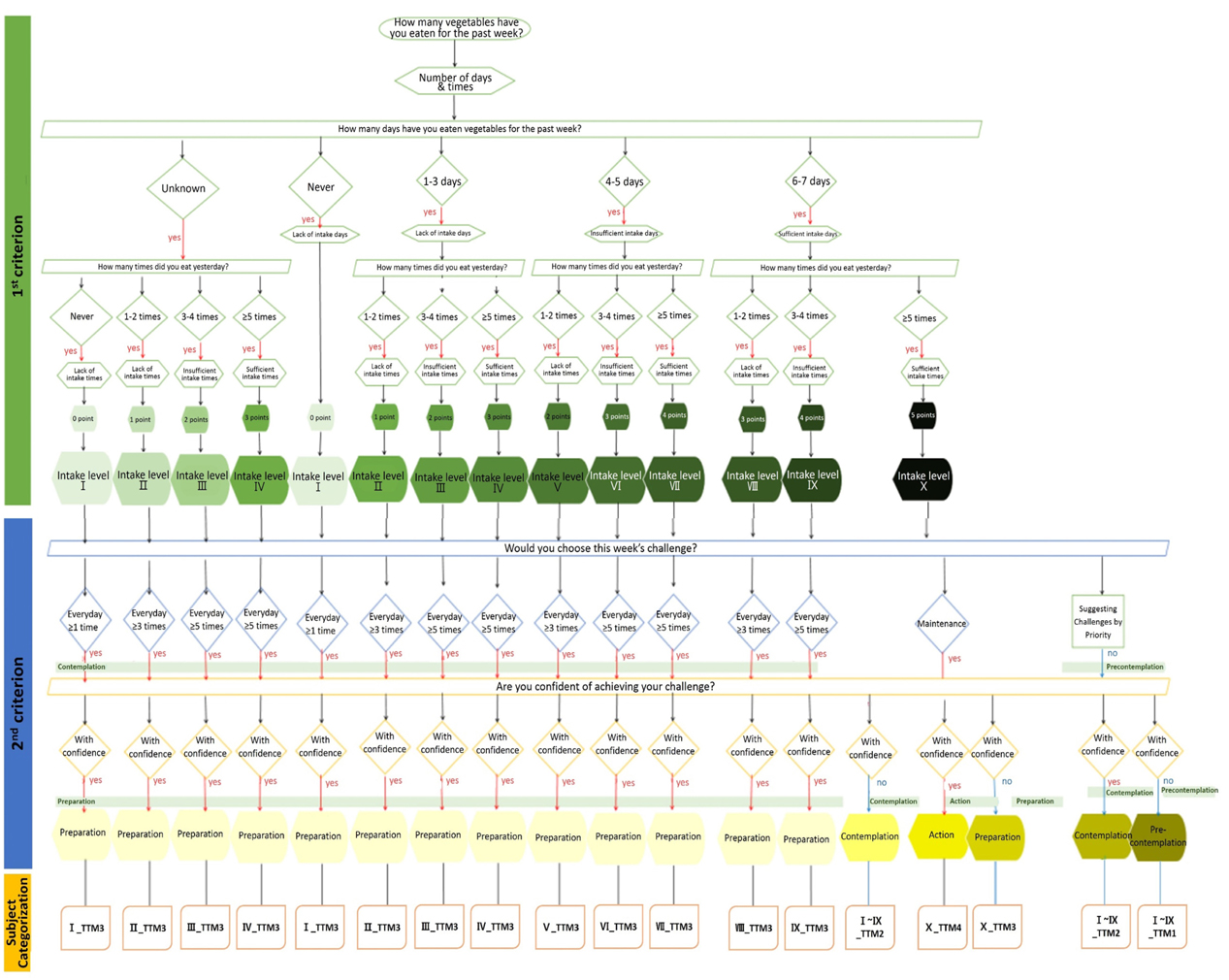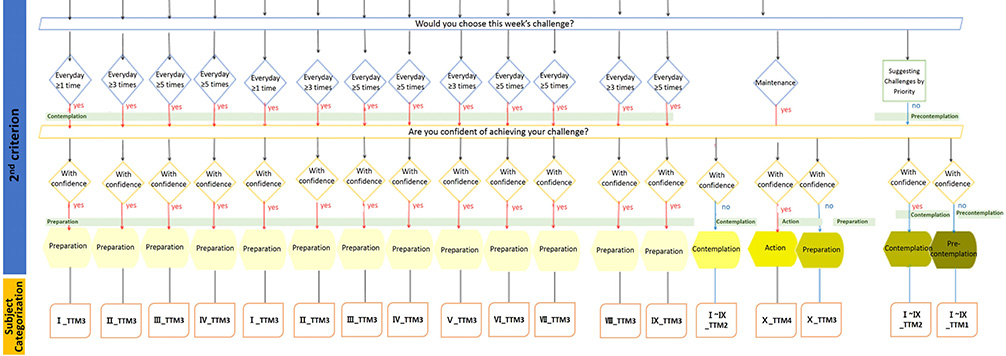Development of tailored nutrition information messages based on the transtheoretical model for smartphone application of an obesity prevention and management program for elementary-school students
- Affiliations
-
- 1Department of Foodservice Management and Nutrition, Sangmyung University, 20 Hongjimun 2-gil, Jongno-gu, Seoul 03016, Korea. jiyunhk@smu.ac.kr
- 2Department of Food Science and Nutrition, Dankook University, Chungnam 31116, Korea.
- 3Department of Food and Nutrition, Daejeon University, Daejeon 34520, Korea.
- 4Department of Family Medicine, Kangbuk Samsung Hospital, Sungkyunkwan University School of Medicine, Seoul 03181, Korea.
- 5Department of Family Medicine, Seoul Paik Hospital, Inje University College of Medicine, Seoul 04551, Korea.
- KMID: 2407773
- DOI: http://doi.org/10.4162/nrp.2017.11.3.247
Abstract
- BACKGROUND/OBJECTIVES
Easy access to intervention and support for certain behaviors is important for obesity prevention and management. The available technology such as smartphone applications can be used for intervention regarding healthy food choices for obesity prevention and management in elementary-school students. The transtheoretical model (TTM) is comprised of stages and processes of change and can be adopted to tailored education for behavioral change. This study aims to develop TTM-based nutrition contents for mobile applications intended to change eating behaviors related to weight gain in young children.
SUBJECTS/METHODS
A synthesized algorithm for tailored nutrition messages was developed according to the intake status of six food groups (vegetables, fruits, sugar-sweetened beverages, fast food and instant food, snacks, and late-night snacks), decision to make dietary behavioral changes, and self-confidence in dietary behavioral changes. The messages in this study were developed from December 2014 to April 2015. After the validity evaluation of the contents through expert consultation, tailored nutrition information messages and educational contents were developed based on the TTM.
RESULTS
Based on the TTM, stages of subjects are determined by their current intake status, decision to make dietary behavioral changes, and self-confidence in dietary behavioral changes. Three versions of tailored nutrition messages at each TTM stage were developed so as to not send the same messages for three weeks at most, and visual materials such as figures and tables were developed to provide additional nutritional information. Finally, 3,276 tailored nutrition messages and 60 nutrition contents for applications were developed.
CONCLUSIONS
Smartphone applications may be an innovative medium to deliver interventions for eating behavior changes directly to individuals with favorable cost-effectiveness. In addition, using the TTM for tailored nutrition education for healthy eating is an effective approach.
Keyword
MeSH Terms
Figure
Cited by 3 articles
-
Evidence-based customized nutritional intervention improves body composition and nutritional factors for highly-adherent children and adolescents with moderate to severe obesity
Jieun Kim, YoonMyung Kim, Young-Gyun Seo, Kyung-Hee Park, Han Byul Jang, Hye-Ja Lee, Sang Ick Park, Hyunjung Lim
Nutr Res Pract. 2020;14(3):262-275. doi: 10.4162/nrp.2020.14.3.262.Research trends in obesity & obesogenic environments in Korea
Myoungsook Lee
Nutr Res Pract. 2019;13(6):461-472. doi: 10.4162/nrp.2019.13.6.461.Impacts of menu information quality and nutrition information quality on technology acceptance characteristics and behaviors toward fast food restaurants' kiosk
Jihee Han, Hyeyoung Moon, Yoonha Oh, Ji Yun Chang, Sunny Ham
Nutr Res Pract. 2020;14(2):167-174. doi: 10.4162/nrp.2020.14.2.167.
Reference
-
1. Jung YH, Ko SJ, Lim H. The socioeconomic cost of adolescent obesity. Health Soc Welf Rev. 2010; 30:195–219.
Article2. Whitaker RC, Wright JA, Pepe MS, Seidel KD, Dietz WH. Predicting obesity in young adulthood from childhood and parental obesity. N Engl J Med. 1997; 337:869–873.
Article3. Lalonde M. A New Perspective on the Health of Canadians: a Working Document. Ottawa: Government of Canada;1974.4. Kim YS, Shin JK, Hong IS, Kim SH, Chang UJ. Weight control program through the fortification of food consumption monitoring on obese female college students-using smart-phone with real time communication application. Korean J Community Nutr. 2011; 16:697–705.
Article5. Verhoeven F, van Gemert-Pijnen L, Dijkstra K, Nijland N, Seydel E, Steehouder M. The contribution of teleconsultation and videoconferencing to diabetes care: a systematic literature review. J Med Internet Res. 2007; 9:e37.
Article6. Kim YA. Our Class Revolution: Current situation of Smart Learning and Development Plan (OR2011-02-7). Seoul: Korean Educational Development Institute;2011.7. Burke LE, Styn MA, Sereika SM, Conroy MB, Ye L, Glanz K, Sevick MA, Ewing LJ. Using mHealth technology to enhance self-monitoring for weight loss: a randomized trial. Am J Prev Med. 2012; 43:20–26.8. de Niet J, Timman R, Bauer S, van den Akker E, de Klerk C, Kordy H, Passchier J. Short message service reduces dropout in childhood obesity treatment: a randomized controlled trial. Health Psychol. 2012; 31:797–805.
Article9. Turner-McGrievy GM, Beets MW, Moore JB, Kaczynski AT, Barr-Anderson DJ, Tate DF. Comparison of traditional versus mobile app self-monitoring of physical activity and dietary intake among overweight adults participating in an mHealth weight loss program. J Am Med Inform Assoc. 2013; 20:513–518.
Article10. Woolford SJ, Clark SJ, Strecher VJ, Resnicow K. Tailored mobile phone text messages as an adjunct to obesity treatment for adolescents. J Telemed Telecare. 2010; 16:458–461.
Article11. Kim JW, Lee EJ. Current status of dietary education applications (App) as a smart education material. J Korean Pract Arts Educ. 2013; 26:81–110.12. Prochaska JO, DiClemente CC, Norcross JC. In search of how people change. Applications to addictive behaviors. Am Psychol. 1992; 47:1102–1114.
Article13. Prochaska JO, DiClemente CC. Stages and processes of self-change of smoking: toward an integrative model of change. J Consult Clin Psychol. 1983; 51:390–395.
Article14. Prochaska JO, Redding CA, Evers KE. The transtheoretical model and stages of change. In : Glanz K, Rimer BK, Viswanath K, editors. Health Behavior and Health Education. San Francisco (CA): John Wiley & Sons;2008. p. 97–122.15. Kim NH, Jun SS, Kim YH, Kim JS, Hwang SK. Application of the transtheoretical model to obese adolescents' exercise behavior change stages. J Korean Soc Health Educ Promot. 2005; 22:103–115.16. Lee YM, Park HS. A study on the stage of change in exercise behaviors, exercise self efficacy, depression and stress in middle aged women. Korean J Women Health Nurs. 2004; 10:218–225.
Article17. Cho SY. Comparison of process of change, self-efficacy, decisional balance and personality by the stages of exercise behavior in middle-aged women [master's thesis]. Suwon: Ajou University;2010. –. .18. Kim YH, Kim JS, Kim MS. Effectiveness of public health center smoking cessation counseling program using the transtheoretical model. J Korean Acad Nurs. 2009; 39:469–479.
Article19. Kim SO. The development and effects of a medication adherence intervention program for hypertensive patients. J Korean Acad Community Health Nurs. 2011; 22:342–354.
Article20. Yoo CY. A study of effectiveness of group program for domestic violent offender's problem drinking. Korean J Soc Welf Stud. 2002; 20:85–116.21. Oh HS, Kim YR. Changing mechanisms corresponding to the changing stages of smoking cessation. J Nurs Acad Soc. 1996; 26:820–832.
Article22. Carvalho de Menezes M, Bedeschi LB, Santos LC, Lopes AC. Interventions directed at eating habits and physical activity using the Transtheoretical Model: a systematic review. Nutr Hosp. 2016; 33:586.
Article23. Free C, Phillips G, Galli L, Watson L, Felix L, Edwards P, Patel V, Haines A. The effectiveness of mobile-health technology-based health behaviour change or disease management interventions for health care consumers: a systematic review. PLoS Med. 2013; 10:e1001362.
Article24. Kim HH, Seo HJ. HealthTWITTER initiative: design of a social networking service based tailored application for diabetes self-management. Healthc Inform Res. 2014; 20:226–230.
Article25. Lee MK, Park HA, Yun YH, Chang YJ. Development and formative evaluation of a web-based self-management exercise and diet intervention program with tailored motivation and action planning for cancer survivors. JMIR Res Protoc. 2013; 2:e11.
Article26. Partridge SR, McGeechan K, Hebden L, Balestracci K, Wong AT, Denney-Wilson E, Harris MF, Phongsavan P, Bauman A, Allman-Farinelli M. Effectiveness of a mHealth lifestyle program with telephone support (TXT2BFiT) to prevent unhealthy weight gain in young adults: randomized controlled trial. JMIR Mhealth Uhealth. 2015; 3:e66.
Article27. Kang MH, Lee JS, Kim HY, Kwon S, Choi YS, Chung HR, Kwak TK, Cho YH. Selecting items of a food behavior checklist for the development of nutrition quotient (NQ) for children. Korean J Nutr. 2012; 45:372–389.
Article28. Centers for Disease Control and Prevention (KR). National Dietary Guidelines for Children. Seoul: Centers for Disease Control and Prevention;2010.29. Lin PH, Wang Y, Levine E, Askew S, Lin S, Chang C, Sun J, Foley P, Wang H, Li X, Bennett GG. A text messaging-assisted randomized lifestyle weight loss clinical trial among overweight adults in Beijing. Obesity (Silver Spring). 2014; 22:E29–E37.
Article30. Ministry of Health and Welfare, Korea Centers for Disease Control and Prevention. Korea Health Statistics 2010: Korea National Health and Nutrition Examination Survey (KNHANES V-1). Cheongwon: Korea Centers for Disease Control and Prevention;2011.31. Andrés A, Juana G, Carmina S. The transtheoretical model and obesity: a bibliometric study. Scientometrics. 2007; 73:289–301.
Article32. Kim BH, Lim H. Effects of customized nutritional education ‘change 10 habits’ program according to stage of behavior change in mildly obese adults. J Korean Diet Assoc. 2015; 21:215–226.
Article33. Logue E, Sutton K, Jarjoura D, Smucker W, Baughman K, Capers C. Transtheoretical model-chronic disease care for obesity in primary care: a randomized trial. Obes Res. 2005; 13:917–927.
Article34. Woolford SJ, Clark SJ, Strecher VJ, Resnicow K. Tailored mobile phone text messages as an adjunct to obesity treatment for adolescents. J Telemed Telecare. 2010; 16:458–461.
Article
- Full Text Links
- Actions
-
Cited
- CITED
-
- Close
- Share
- Similar articles
-
- Development and Application of a Web-Based Tailored Nutrition Management Program and Change in Knowledge of Nutrition and Eating Habits in Elementary Students
- Development of a Smartphone Application for 4th-6th Grade Elementary Students Aimed to Prevent Childhood Obesity
- Development of a Smartphone Application Prototype for Child Obesity Prevention: Rationale and Study Design of Acceptability and Feasibility Tests
- Design of service delivery for a child obesity prevention and management program using technology convergence
- Acceptability and Feasibility of a Smartphone Application for 5th, 6th Grade Elementary Students to Prevent Childhood Obesity; a Qualitative Study







